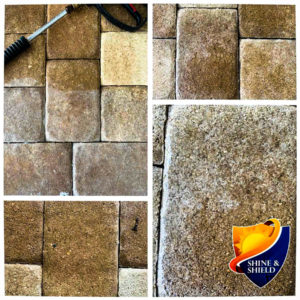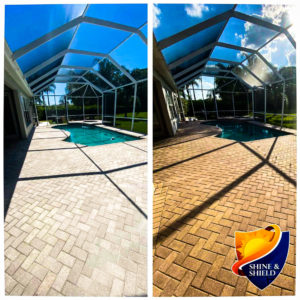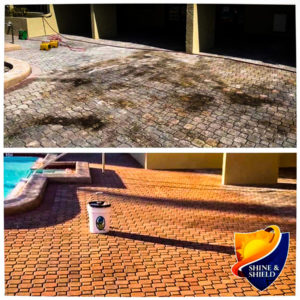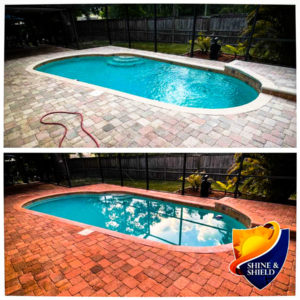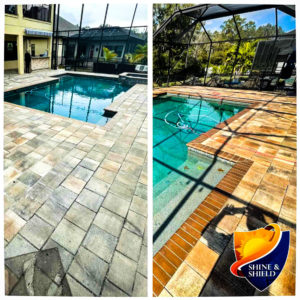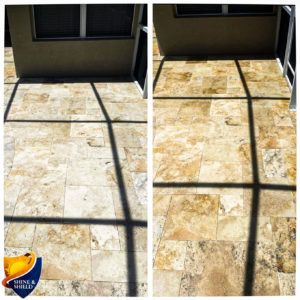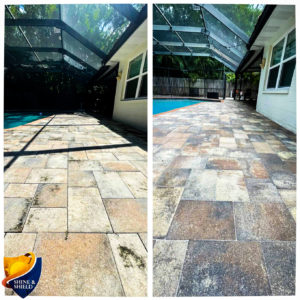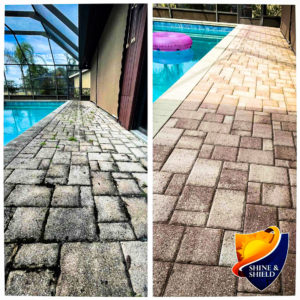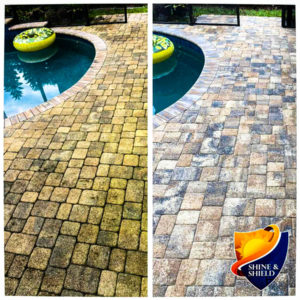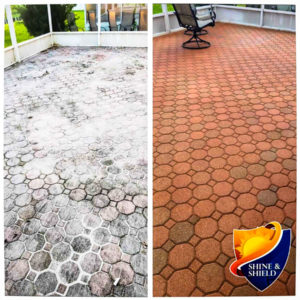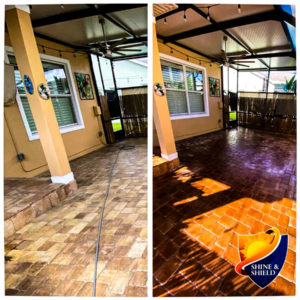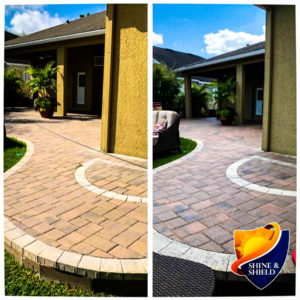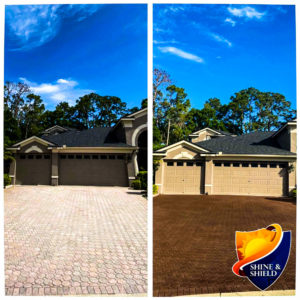Paver Stripping
Paver Stripping Restoration
Whiting happens when your pavers have been sealed with a xylene or acrylic (solvent-based) sealer or sealed during imperfect weather condition or application. The trapped moisture is caused by hydrostatic pressure, which brings the moisture up through the pores of the pavers and trapping it under the sealer. Once your pavers have “turned white”, there is only one way to rectify the problem. The sealer must be completely stripped off and re-sealed with the correct type of sealer; also known as paver
restoration. These sealants will begin to turn a hazy white color (often times within the first 3 months or the first few rain falls, if not sooner) and in some extreme cases, even look like someone squirted white Elmer’s glue inthe joints!
What's the best paver sealer for Southwest Florida then?
Before I tell you what the best sealer is, it’s really important that you understand the dangers of using xylene or acrylic based brick paver sealers. These types are extremely inexpensive which is why a lot of homeowners and contractors are willing to use them. But these sealers have extremely high levels of VOCs (volatile organic compounds) and have a negative effect on both the installer and the environment.
In fact, back in 2005 NY, PA, VA, DE, NJ, MD, and DC lowered the maximum levels of VOC’s to 400 g/l. Los Angeles and Orange counties in CA have lowered the allowable levels to 100 g/l. This essentially prohibits the the use of solvent-based brick paver sealers in these areas.
If you still choose to use them here in Tampa Bay, Florida and surrounding areas know this…they will turn white. In addition, most paver restoration companies charge $2.50 or more per square foot to strip off the old sealer. Avoid this costly mistake by choosing the right sealer and a contractor who is trained and insured.
We use a proprietary water based sealer specifically made for Florida’s subtropical climate. It is designed preserve, protect and prolong your paver asset’s life cycle by extending the life expectancy of your property, plus contribute to the ease of maintenance of these surfaces, thereby reducing cleaning costs and preserving the surface material.
Stripping off Failed Paver Sealant
How could 1 product have multiple names? A solvent simply means “to dissolve”. A solvent is a very toxic brick paver sealer often composed of Xylene for the brick paver application. It is an acrylic type of paver sealer. Often times, acrylics are referred to as oils. The reason I tell you this is because homeowners will hear through the community that a contractor used a solvent based sealant on their pavers and it turned white, and the contractor will then say “Oh, well we use a Xylene based or an oil based sealer” in hopes to make the uneducated home owner think it’s a different product. These types of sealants are actually great sealers up north. But here in the Tampa bay area of Florida, there is too much moisture in the ground for these paver sealants to have a positive outcome.
Where in Florida is it considered Sub-Tropical Climate?
All hope is not completely lost. You have 2 options: live with ugly pavers and let it wear off in about 8-10 years. Or give us a call for a free estimate to have the failed paver sealer stripped off completely and resealed the right way.
If you want colorful, vibrant pavers again, choose a wise contractor who only uses water based sealers!
Our paver restoration process can eliminate the whiting, remove the old sealant, and re-seal to bring back the beauty and color of your pavers.
Identify
First thing we do is consult with you and identify the problem and educate you on how we can fix it. We will discuss details such as the process and pricing. This is done during our onsite evaluation/consultation.
Begin Restoration Process
The day of the appointment we will begin by stripping off the old sealer. This takes a lot of time and attention to detail. We get every nook & cranny in order to restore your pavers correctly.
Clean Up and Re-Seal
Our service area includes: the Tampa Bay area, Lutz, Westchase, Carrolwood, Northdale, Citrus Park, Odessa, Land O Lakes, Temple Terrace, Wesley Chapel, West Tampa, South Tampa, New Tampa, Tampa Palms, Riverview, New Tampa, Seffner, Brandon, Apollo Beach, Valrico, Fish Hawk, Bloomingdale, and more.

